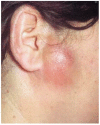The Emergencies in the Group of Patients with Temporomandibular Disorders
- PMID: 36615097
- PMCID: PMC9821445
- DOI: 10.3390/jcm12010298
The Emergencies in the Group of Patients with Temporomandibular Disorders
Abstract
Temporomandibular disorder is a musculoskeletal disease with complex, multifactorial etiology regarding improper functioning of the stomatognathic system (masticatory muscles, temporomandibular joints, and surrounding structures). This article presents medical emergencies occurring among patients treated for temporomandibular disorders, which tend to constitute a severe difficulty for practitioners during their clinical practice. Examples of the most common emergencies of this type are disc displacement without reduction and a sudden contraction of the inferior part of the lateral pterygoid muscle. The latter occurs in cases of uncontrolled and incorrect use of the anterior repositioning splints and the hypertrophy of the coronoid process of the mandible. The sudden attacks of pain of secondary trigeminal neuralgia are also discussed in this article, together with their specific nature, which is significantly different from the nature of the pain of primary trigeminal neuralgia, yet the two types of neuralgia can be easily confused when the primary one takes the painful form. Subsequent emergencies discussed are myofascial pain syndrome, traumatic and inflammatory states of the temporomandibular joints, subluxation, and the consequences of intense occlusive parafunctions. Finally, the recommended therapeutic methods, which are used as part of the treatment in the cases of aforementioned emergencies, are described in this mini-review article, emphasizing that the implementation of the incorrect treatment and rehabilitation for emergencies of temporomandibular disorders may lead to permanent damage to the soft tissue structures of the temporomandibular joints.
Keywords: TMD; differential diagnosis; emergencies; management of TMD; myospasm of pterygoid muscle; rehabilitation; subluxation of mandible; temporomandibular disorders.
Conflict of interest statement
The authors declare no conflict of interest.
Figures




Similar articles
-
The significance of masticatory muscle's relaxation in the treatment of the temporomandibular disorders - Review article.Folia Med Cracov. 2023 Apr 30;63(1):45-52. doi: 10.24425/fmc.2023.145429. Folia Med Cracov. 2023. PMID: 37406276 Review.
-
Cause-Effect Relationships between Painful TMD and Postural and Functional Changes in the Musculoskeletal System: A Preliminary Report.Pain Res Manag. 2022 Feb 28;2022:1429932. doi: 10.1155/2022/1429932. eCollection 2022. Pain Res Manag. 2022. PMID: 35265232 Free PMC article.
-
The Efficiency of Anterior Repositioning Splints in the Management of Pain Related to Temporomandibular Joint Disc Displacement with Reduction.Pain Res Manag. 2018 Feb 21;2018:9089286. doi: 10.1155/2018/9089286. eCollection 2018. Pain Res Manag. 2018. PMID: 29682131 Free PMC article.
-
Conservative management of temporomandibular dysfunction: A literature review with implications for clinical practice guidelines (Narrative review part 2).J Bodyw Mov Ther. 2017 Jul;21(3):541-548. doi: 10.1016/j.jbmt.2017.05.021. Epub 2017 Jun 1. J Bodyw Mov Ther. 2017. PMID: 28750962 Review.
-
[Evaluation of Lateral Pterygoid Muscle Contraction in Patients with Temporomandibular Disorders Based on 3D-T2 Weighted Imaging].Zhongguo Yi Xue Ke Xue Yuan Xue Bao. 2021 Aug;43(4):579-583. doi: 10.3881/j.issn.1000-503X.13076. Zhongguo Yi Xue Ke Xue Yuan Xue Bao. 2021. PMID: 34494529 Chinese.
Cited by
-
Kinesio Taping as a Therapeutic Tool for Masticatory Myofascial Pain Syndrome-An Insight View.Int J Environ Res Public Health. 2023 Feb 22;20(5):3872. doi: 10.3390/ijerph20053872. Int J Environ Res Public Health. 2023. PMID: 36900882 Free PMC article. Review.
-
Effectiveness of Rehabilitation for Disk Displacement of the Temporomandibular Joint-A Cross-Sectional Study.J Clin Med. 2024 Feb 4;13(3):902. doi: 10.3390/jcm13030902. J Clin Med. 2024. PMID: 38337596 Free PMC article.
-
Temporomandibular Joint Disorders: Functional and Conservative Treatment.J Clin Med. 2023 Jul 19;12(14):4772. doi: 10.3390/jcm12144772. J Clin Med. 2023. PMID: 37510887 Free PMC article.
-
A New Mechanical Mouth Opener for Dynamic Magnetic Resonance Imaging of the Temporomandibular Joint.J Clin Med. 2023 Jul 31;12(15):5035. doi: 10.3390/jcm12155035. J Clin Med. 2023. PMID: 37568437 Free PMC article.
-
Knowledge and awareness about temporomandibular disorder among dentists in India: Questionnaire study and review.J Indian Prosthodont Soc. 2024 Jul 1;24(3):284-291. doi: 10.4103/jips.jips_573_23. Epub 2024 Jul 1. J Indian Prosthodont Soc. 2024. PMID: 38946513 Free PMC article. Review.
References
-
- Wright E., Klasser G. Management of Temporomandibular Disorders. 4th ed. Wiley—Blackwell; Hoboken, NJ, USA: 2019.
-
- Fale H., Hnamte L., Deolia S., Pasad S., Kohale S., Sen S. Association between parafunctional habit and sign and symptoms of temporomandibular dysfunction. J. Dent. Res. Rev. 2018;5:17. doi: 10.4103/jdrr.jdrr_1_18. - DOI
Publication types
LinkOut - more resources
Full Text Sources

